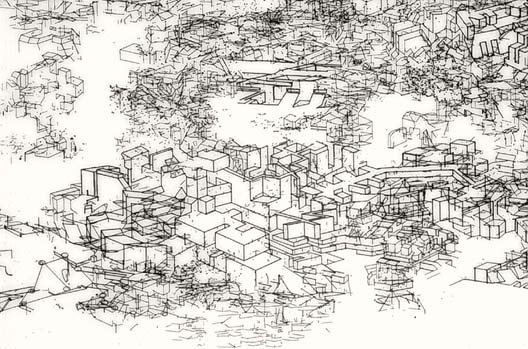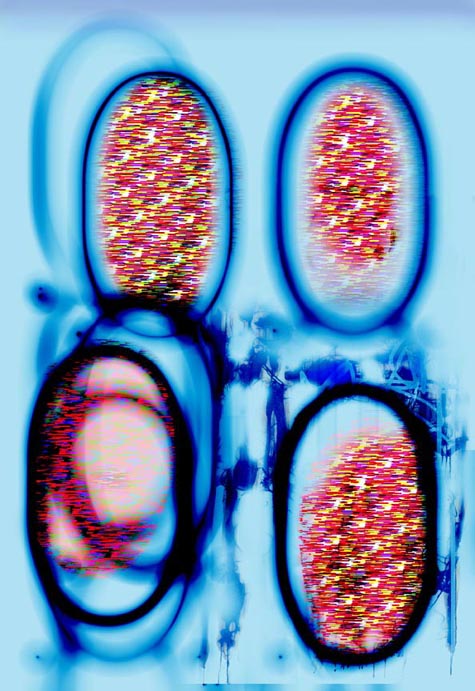PALO ALTO DREAMIN'
Page Three

Marsha Cottrell, Untitled #20 (detail), 1999
Unique laser print on Mylar, 8.5" x 11" In Cottrell's work, punctuation marks--slashes, commas, colons, brackets--are fragmented and stretched into hair-thin lines, which serve as the raw material for chaotic or crystalline abstractions. Printed in black and white on Mylar sheets resembling vellum, these semi-amorphous blurs suggest architectural plans for oddly-angled, retro-futuristic cityscapes, growing and decaying in fractal swamps. By repurposing characters from a standard font file, originally meant for word processing, into a malleable, intricate drawing medium, she practices a kind of cyber-alchemy: as critic Sarah Schmerler eloquently puts it, "Cottrell isn't simply making drawings with a new medium, she's using it as a kind of poetic device, creating pictorially compelling spaces out of the pauses within speech."(*) Matt Chansky also imports typography (as well as clip art, error messages, and other information) into his digital paintings, and after he has applied "wash" or "rinse" files that soften or intensify the images, it becomes difficult to tell these sources apart. Often it's not clear if what the viewer is seeing are gestures in a paint program, fuzzed-out, clip-art drips, or actual paint (it's printed ink, but laminated behind Plexiglas it's hard to tell). Sometimes Chansky samples the computer's "display errors," which are fields of pixelated static occurring when the machine is taxed for memory. He has learned how to create these one-off patterns--seductive, mazelike networks of horizontals and verticals--by deliberately putting the computer under stress, introducing specific images as a sort of catalyst and taking screen captures of the results.(**)
 Matt Chansky, Static & Blues_4, 2001, ink on paper, Plexiglas, 50" X 34"
After further "cultivation" and "maturation" in an imaging program, he integrates the captures into larger compositions. In Static & Blues_4, he places four oval-shaped patches, all based on the same error (with varying constituent colors added or subtracted so no two patches look alike), slightly off-register within loops of what looks like drippy, washy paint. The resulting image is an iconic, punning take on the spiritualist impulse, as it has evolved between the early 20th Century and now. While the painted areas suggest messages coming "from within" the artist by mediumistic transcription (or via its descendant, AbEx gesture painting), the pixelated areas are snapshots of the machine's unconscious. Only the latter, however, are truly "automatic." *Sarah Schmerler, review of "Cyber drawings," Art on Paper, May-June 2000, p. 81 **Emails from Matt Chansky, May 29 and July 30, 2001 To view Page Four, click button below.
Back to criticism / weblog.
|